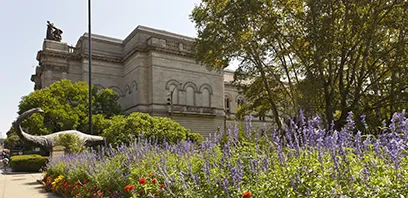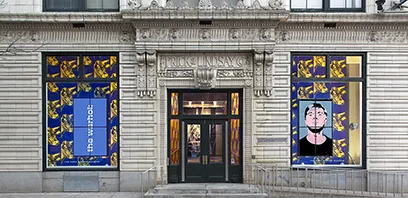by Kathryn M. DudaLike most Depression-era families, the Warholas found daily
life difficult. Money was in short supply, and the family stretched what little they
had in order to make ends meet. Added to that, the Warholas had essentially a single-parent
home. As head of the household, Andrej Warhola was often out of town working grueling
12-hour shifts in heavy construction, thus forced to leave the care of the home and
three boys to his wife, Julia. These periods were interrupted by stretches when Andrej
was out of work, which provided times for family togetherness but tainted it with
the strain of additional financial worry.
An exhibition of objects used by the Warhola family during that time has been assembled
by The Andy Warhol Museum’s Archives Study Center and is on view there through September
29. These everyday items, on loan to the museum from Andy’s brother John Warhola,
give today’s audience a sense of the life that the family led during the 1930s and
40s. While Andy seldom talked of his childhood, his experiences during those years
shaped his character and his art, and that influence becomes obvious when one studies
the items in the exhibition.
Unlike his brothers, Paul and John, Andy Warhola was a shy boy and spent a great
deal of time at home with his mother. Under her tutelage he began to develop his artistic
ideas and skills, while his brothers played ball outside. Julia was a folk artist
in her own right, creating and selling handicrafts, stenciling her family’s furniture,
and drawing pictures of religious scenes and animals for her sons. After Andy established
himself as an artist in New York, Julia moved in with him and a mother-son collaboration
developed in which she embellished Andy’s works with her whimsical penmanship and
drawings. Julia signed Andy’s commercial illustrations into the 1960’s.
Home, family and religion — values imported from Czechoslovakia by Andrej and
Julia — were paramount to the Warholas, as they were in most families 60 years ago.
With fewer distractions to take people away from home during the Depression years,
families like the Warholas relied on each other for entertainment, inspiration and
support.
Since few non-essentials could be purchased, Andrej Wahola fashioned and maintained
tools, kitchenware and other utilitarian objects, several of which are included in
the current exhibition at The Andy Warhol Museum. Among these are two implements central
to an Eastern-European kitchen — a potato masher and potato spoon, both large and
sturdy wooden objects that saw frequent use in preparing mashed potatoes and piroghi.
Equally important in the preparation of meals was a sauerkraut masher, which Andrej
crafted once his sons were too big to mash kraut the traditional way — by stomping
on it. A thick, heavy, wooden bread board and an ample mixing bowl are also exhibited,
testimonies to the task of breadbaking that was a routine part of a housewife’s daily
chores.
Nothing of potential re-use was thrown away during the Depression years, so an
efficient system for shoe repair was essential. Andrej’s workbench included a shoemaker’s
cast- iron forms, in various sizes, to hold the family’s shoes while he stitched a
tear or replaced a worn sole.
“Sometimes he’d buy a piece of leather to replace soles on our good shoes,
the ones that we’d wear to church,” remembers John Warhola. But more often than
not, Andrej would cut up old tires to form the new soles.
Always obsessed with people’s appearance, Andy had a lifelong aversion to his own
looks, which included blotchy skin and a bulbous nose. In what museum archivists have
identified as his first self-portrait, Andy confronts his insecurities about his features
and creates a startlingly revealing image of himself at the probable age of 16. The
signature, “A. Warhol,” already minus the final “a,” is highly
stylized and, according to Assistant Archivist Matt Wrbican, shows that Andy was mimicking
the style of commercial illustrators of the early 1940s.
Because Andy Warhol was such a private man, most people are unaware that he was
a devout Byzantine Catholic all his life. As children, the Warhola boys accompanied
their parents to mass at St. John Chrysostom Church near their home in lower Greenfield
(Ruska Dolina). The parish was comprised primarily of Carpatho-Rusyn immigrants like
Andrej and Julia, and after the family moved they would walk nearly a mile in any
weather to attend mass there.
Their religion did not stop at the doors of the church, however. “There was
at least one religious picture in every room,” says John Warhola of his family
home. One of these was a 17-inch-high religious shrine that Andy painted and kept
in his bedroom. Cast from a mold in plaster of Paris, the shrine is brightly painted
and once held two candles. It is part of the current exhibition in the museum as well.
“Andy was always shy about being religious,” recalls John, “because
the other kids would make fun of him.” This reluctance to be open about his religion
stayed with him throughout his life, his brother says. Andy and his mother attended
a Byzantine Catholic church in New York while Julia was alive, even travelling by
taxi with a basket of food to be blessed at Easter time. He continued to attend daily
mass for the rest of his life, but a near-death experience caused him to temporarily
change his church-going pattern.
“After Andy was shot, he had a fear of crowds for awhile and for that reason
didn’t go to mass,” John says. “Instead, he’d go in to church after mass
was over and say his prayers.” Other items in the exhibition attest to the better-known
side of Andy Warhol, such as the family camera and the scrapbook of movie stars’ photographs,
both of which suggest the artist’s fascination with image, star status and capturing
a moment in time. While these items are interesting in an obvious way, museum visitors
will be especially touched by the simpler objects on display — the everyday things
that provide a glimpse of the boy drinking Ovaltine behind his mother’s skirts.
Kathryn M. Duda is associate editor of Carnegie Magazine.
Return to the Table of Contents.
At Home in Pittsburgh: Andy Warhol’s Youth (Jul/Aug 1996)
by Kathryn M. DudaLike most Depression-era families, the Warholas found daily life difficult. Money was in short supply, and the family stretched what little they had in order to make



